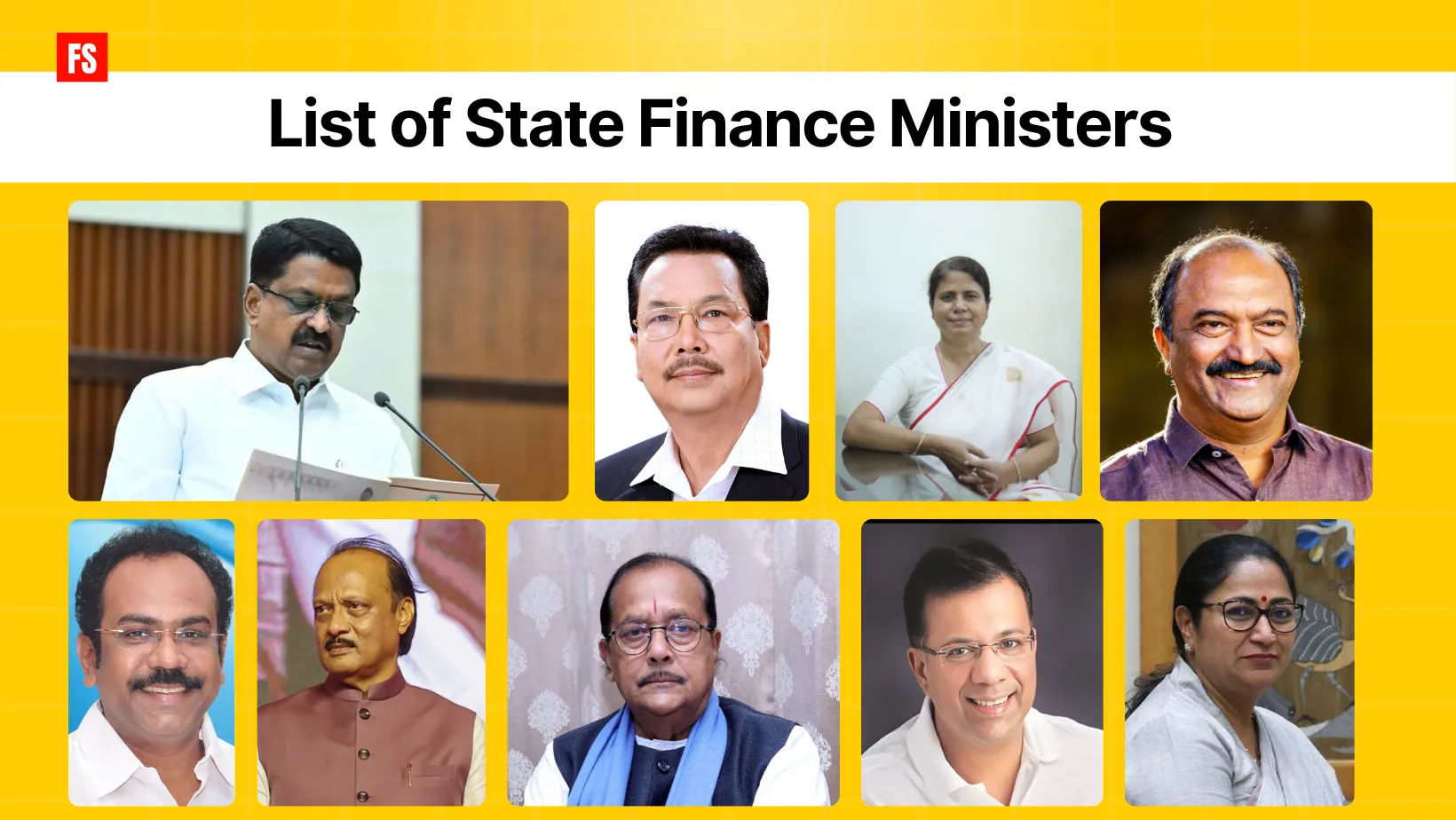India is a federal country, meaning powers are divided between the Union Government and the State Governments. While the Union Finance Minister manages the national budget, taxation, and macroeconomic policy, every state in India also has its own Finance Minister. These leaders are responsible for presenting the state budget, allocating funds for development, and ensuring fiscal discipline. In this blog, we’ll provide the complete list of State Finance Ministers of India (2025), explain their roles, and discuss some of the key highlights from recent state budgets.
Let’s explore State Finance Ministers of India (2025);
Why Do States Have Finance Ministers?
Finance Ministers at the state level handle critical responsibilities such as:
- Preparing and presenting the State Budget every year.
- Managing state revenue sources like SGST, excise duty, land revenue, and stamp duty.
- Deciding allocations for health, education, infrastructure, and welfare.
- Managing debt and borrowing for large projects.
- Negotiating with the Central Government for tax devolution and grants.
In some states, the Chief Minister also holds the Finance portfolio (like in Karnataka). This makes the role even more politically significant.
Who is the Current Finance Minister of India?
The Finance Minister of India plays a crucial role in shaping the country’s economic policy, managing public finances, and presenting the annual Union Budget.
As of September 2025, the current Finance Minister of India is Nirmala Sitharaman, a prominent political leader and one of the most influential figures in India’s economic landscape.
Nirmala Sitharaman has been serving as India’s Finance Minister since May 30, 2019. She continued in the role following the 2024 general elections, making her one of the most consistent figures in the Indian government’s economic management.
Sitharaman is a senior leader of the Bharatiya Janata Party (BJP) and has represented Karnataka in the Rajya Sabha since 2016. Her political career spans several important ministerial positions, including serving as Union Defence Minister from 2017 to 2019, making her the second woman in India’s history to hold this prestigious portfolio.
Now we will see the state finance ministers of India;
List of State Finance Ministers of India (2025)
| State / UT | Finance Minister |
|---|---|
| Finance Minister Of Andhra Pradesh | Payyavula Keshav |
| Finance Minister Of Arunachal Pradesh | Chowna Mein |
| Finance Minister Of Assam | Ajanta Neog |
| Finance Minister Of Bihar | Samrat Choudhary |
| Finance Minister Of Chhattisgarh | Om Prakash Choudhary |
| Finance Minister Of Delhi (NCT) | Rekha Gupta |
| Finance Minister Of Goa | Vishwajit Pratapsingh Rane |
| Finance Minister Of Gujarat | Kanubhai Desai |
| Finance Minister Of Haryana | Jai Parkash Dalal |
| Finance Minister Of Himachal Pradesh | Sukhvinder Singh Sukhu |
| Finance Minister Of Jharkhand | Radhakrishna Kishore |
| Finance Minister Of Karnataka | Siddaramaiah |
| Finance Minister Of Kerala | K. N. Balagopal |
| Finance Minister Of Madhya Pradesh | Jagdish Devda |
| Finance Minister Of Maharashtra | Ajit Pawar |
| Finance Minister Of Manipur | Dr Vineet Joshi |
| Finance Minister Of Meghalaya | Conrad Kongkal Sangma |
| Finance Minister Of Mizoram | Pu Lalduhoma |
| Finance Minister Of Nagaland | Neiphiu Rio |
| Finance Minister Of Odisha | Mohan Charan Majhi |
| Finance Minister Of Punjab | Harpal Singh Cheema |
| Finance Minister Of Rajasthan | Diya Kumari |
| Finance Minister Of Sikkim | Prem Singh Tamang (Golay) |
| Finance Minister Of Tamil Nadu | Thangam Thennarasu |
| Finance Minister Of Telangana | Bhatti Vikramarka Mallu |
| Finance Minister Of Tripura | Pranajit Singha Roy |
| Finance Minister Of Uttarakhand | Premchand Agarwal |
| Finance Minister Of Uttar Pradesh | Suresh Kumar Khanna |
| Finance Minister Of West Bengal | Chandrima Bhattacharya |
Also Read this: Top 5 Cities in India by GDP (2025)
Role of State Finance Ministers in Shaping India’s Economy
The State Finance Ministers of India don’t just work within their states — they also play a role at the national level.
- They are members of the GST Council, which decides Goods & Services Tax rules and rates for the entire country.
- They influence debates on Centre–State financial relations like revenue sharing.
- They handle implementation of central schemes like PM Awas Yojana, Jal Jeevan Mission, etc., at the state level.
- Their budgets impact millions of citizens — from farmers in Bihar to IT professionals in Karnataka.
Also Read this: India Franchise Market going to hit $140-150 billion – Project 2030
Why It’s Important to Know the State Finance Ministers
- They decide how much money goes into roads, schools, hospitals in each state.
- They affect state-level taxes and revenue (e.g. state GST, local taxes).
- Their policies influence economic growth, investment climate in their state.
- They interact with the central government (for funds, grants, tax sharing) so knowing who holds the finance post is key to understanding politics & budgets.
Challenges State Finance Ministers Face
- Balancing Debt vs Development: States need to borrow for infrastructure etc., but too much debt can lead to problems (interest payments, lower ratings).
- Revenue Constraints: Some states have weak tax bases; collecting revenue is tough.
- Dependence on Centre: Many states rely heavily on transfers and grants from the Union government. Disputes sometimes arise over share, conditionality.
- Inflation & Cost Pressures: Rising costs of fuel, input goods, social welfare push up expenditures.
- Fiscal Discipline Rules: Maintaining revenue surplus, controlling deficit, managing borrowings per rules is tricky.
Also Read this: Top 10 Richest States in India
What We Know & What We Don’t
Known:
- Finance Ministers of Tamil Nadu and Karnataka with clarity and recent actions.
- Key budgeting trends: Infrastructure, welfare, debt control.
- Role overlaps where CM holds Finance.
Less Clear / Unknown:
- Many states’ current finance ministers are not frequently cited in national news, so list of all 28+ states is harder to get reliably.
- Exact budget numbers, assets, or previous portfolios may not always be public.
- Frequent reshuffles can change names quickly.
Tips to Keep Track of State Finance Ministers of India
If you want an up-to-date list of all State Finance Ministers of India, here are tips:
- Check state government official websites or gazettes.
- Follow news around state budget time – finance ministers often come up in coverage.
- Use reliable national portals like PTI, The Indian Express, etc.
- Monitor cabinet reshuffles — states sometimes change their finance ministers.
Also Read this: Top 10 Medicines Companies in India
Conclusion
The State Finance Ministers of India (2025) play a vital role in shaping the country’s financial and developmental landscape. From Maharashtra’s Ajit Pawar managing India’s largest state economy to Tamil Nadu’s Thangam Thennarasu focusing on welfare and infrastructure, each state FM brings unique priorities.
Together, these finance leaders not only manage state budgets but also influence national tax policy through the GST Council, making them critical players in India’s economic future.
If you want to understand India’s growth story, following the State Finance Ministers of India is just as important as tracking the Union Finance Minister.
Sources: Wikipedia
FAQ – State Finance Ministers of India
Payyavula Keshav (Andhra Pradesh) and Diya Kumari (Rajasthan) are among the new finance ministers presenting budgets in 2025.
Not always. UTs with legislatures (like Delhi) have one, but others are managed by the Centre.
Yes. For example, Karnataka’s CM Siddaramaiah holds finance portfolio. That means he does double duty.
They present the state budget, allocate funds across sectors (health, education etc.), manage state borrowing & debt, oversee state tax collection and state government spending.
Tamil Nadu had a change in May 2023 (Thangam Thennarasu replaced PTR).
R.K. Shanmukham Chetty was the first finance minister of India.







